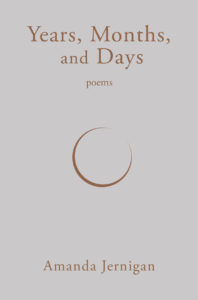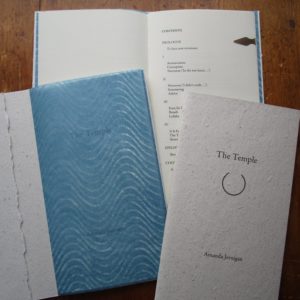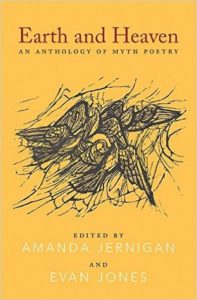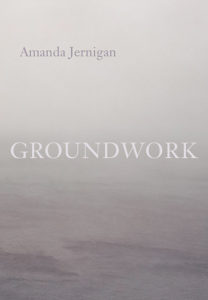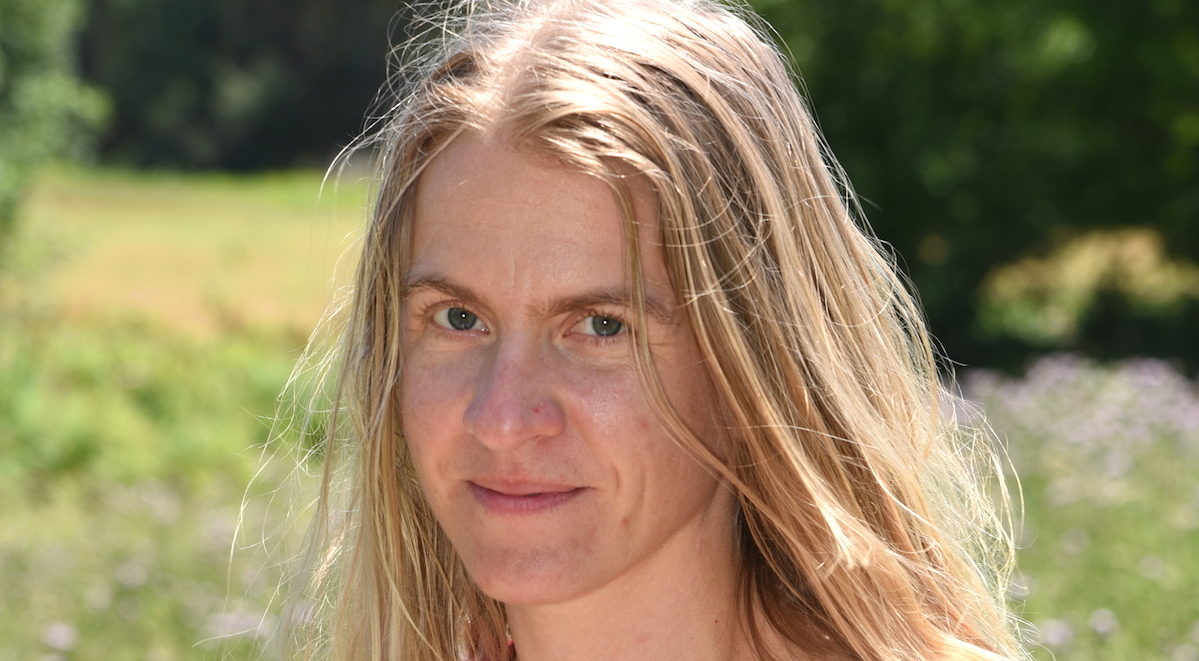
Former PRISM poetry editor Rob Taylor sat down with Amanda Jernigan to discuss her recently released third poetry collection, Years, Months, and Days (Biblioasis, 2018), a book whose content was inspired by a nearly 200-year-old Mennonite hymnal, Die Gemeinschaftliche Liedersammlung.
Three poems from Years, Months, and Days – Amanda Jernigan
I can see the place,
near to me as you are,
clearly as your face,
but I cannot go there.
*
A man
goes here
and there
to sow
the seed
falls here
and there
the birds
go here
and there
to eat
the seed
the man
goes forth
to sow.
*
Summer to autumn,
how do we travel
autumn to winter,
one to another,
winter to springtime,
how do we travel,
springtime to summer,
one to another.
from Years, Months, and Days
(Biblioasis, 2018).
Reprinted with permission.
In the afterword to Years, Months, and Days you note that the poems in the book “are not translations so much as they are meditations on the possibility of translation.” Can you unpack that a bit more? What were the anchoring points which kept the poems tethered in some way to the original text? Do you think there’s a limit, no matter how up-front the translator is, to what can reasonably be considered a “translation”?
In order to consider these poems translations, we have to define the word “translation” very loosely indeed — though as I’ve written elsewhere, the word translation can mean both “carried across” (i.e. preserved) and “transformed” (i.e. changed utterly — as in Shakespeare: Bless thee, Bottom, bless thee! Thou art translated!). So “meditations on the possibility of translation” is really more apt. And the kind of translation at issue here, as I say in the afterword, is not only, or even centrally, translation across languages, but translation “between religions, or between religion and secularity; between a world defined by the presence of God, and a world defined by His absence — or perhaps by other sorts of presences and Presences.” That is to say, I embarked on the work as a secular person, an atheist person, trying to see what I could understand (and not just intellectually, but with all my heart, and with all my soul, and with all my mind, as they say in the Book of Common Prayer) of these hymns that are expressions of religious faith: of the Old Order Mennonite faith specifically, and beyond that of Anabaptist faith more generally, of Protestant faith, of Christian faith.
What I could understand, initially, was very little: that is one reason the poems are so short. I worked not with whole hymns but with fragments of hymns, sometimes mere phrases — but fragments or phrases I felt I could understand. Often these were moments of doubt and darkness in the hymns. Sometimes they were moments of longing. Sometimes they were moments in which faith is expressed through or in the rhythms of the natural world.
What I did not understand, embarking on the work of translation, were, among other things, the words God, Christ, and the Holy Spirit. And such occur very often in the hymnal, as you will not be surprised to hear. So in this sense, as a translator, I was profoundly limited.
But moments of doubt and darkness, of longing, of a deeply felt resonance between the rhythms of faith and the rhythms of the natural world — it turns out that all of these things figure, both in the hymnal and in the mythos that is its source, not at all peripherally. Centrally. So, by following my way along what I felt to be the margins of the text — like Chuchundra, the muskrat in The Jungle Books, who creeps around by the wall out of fear — I found myself caught unawares at the centre. The poems read very differently to me now than they did when I wrote them.
Can you compare your experience with Years, Months, and Days to that of writing your new chapbook, The Temple (Baseline Press, 2018)? The two books are united in that the chapbook is also a rendering of religious song (the text for a new cantata for the Feast of the Presentation). Do you see the two projects as linked?
My process in the writing of The Temple was quite different. It is quite a different book. The two projects were not directly related, though they both have had a life as words for music. The first was commissioned by Inter Arts Matrix as part of a choral work by Colin Labadie, the second by countertenor Daniel Cabena as part of a cantata by Zachary Wadsworth: as such, both projects brought me into meaningful contact with other artists, musicians and composers, whose worlds of art and faith and doubt informed what I ultimately wrote.
But the engagement of Years, Months, and Days is with the texts of specific, German-language Protestant hymns. The Temple engages with the Christian mythos much more generally — but specifically with the mythos, or mythoi, of the Gospels. And I entered this world not from the margins, like Chuchundra, but in the middle, through the experiences of conception and pregnancy and labour and birth and motherhood — in their literal manifestations, and in their imaginal manifestations, also — experiences that are of crucial importance in the Gospels. And I use that word “crucial” advisedly.
The Temple is a story of motherhood, specifically; it is also a story of woman in love more generally. And it is a story that attempts to bring face to face two knowledges: that of Person in Love, in the largest sense; and that of Person Out of Love, or on Love’s margins — of Mary, the new mother, a woman on the verge of life; and of Simeon, the old prophet, a man on the verge of death.
In his introduction to the letters of John Keats, the critic Lionel Trilling writes:
[In this letter, Keats] has brought his two knowledges face to face, the knowledge of the world of circumstance, of death and cancer, and the knowledge of the world of self, of spirit and creation, and the delight in them. Each seems a whole knowledge considered alone; each is but a half-knowledge when taken with the other; both together constitute a truth.
The Temple is, I think, an effort to constitute — or at least to contemplate (the word is cognate with “temple”) — a truth, in this sense.
In the afterword of Years, Months, and Days you mention not being religious yourself, and yet here you are with both of these books (Years, Months, and Days, and The Temple). What’s up?
What’s up, I suppose, is that somehow in the writing of Years, Months, and Days and The Temple — not necessarily because of the writing, but through the time in which the writing took place, and beyond it — those words God, Christ, and the Holy Spirit have come to mean something to me.
In a 2001 interview with Michael Carbert, Richard Outram writes:
… when I say I am a theist, one of the things I certainly mean is that I use the word “God” and if I use the word I have to mean something by it. Or stated negatively, I am not an atheist and I am not an agnostic. But here one is plunged into the very dangerous areas of belief and the question of the nature of belief. I use the word God and I mean something by it. I wish to indicate something about myself and about the nature of reality as I understand it by using that term. But I suspect that what I mean when I use the word is not what most people mean when they use the word. I use it with caution, but in a number of different ways, including the ironical and occasionally the satirical, and I feel free to do that in all conscience. But if you are going to use the word in any meaningful terms then it seems to me that you have to do so on a basis of faith …
I think this puts it very well. In the course of the past year, those words — God, Christ, the Holy Spirit — have come to have some application for me, to indicate something about myself and about the nature of reality as I understand it.
“I believe in God” is not an empty phrase: certainly not as it is enshrined, for instance, in the Creed and elsewhere, in the speech acts of ritual. No more is “I do not believe in God.” But both of these phrases taken in isolation are in a language that is, for me, other than the language of faith and doubt. I suppose that poetry is, for me, among other things, the language — or a language — of faith and doubt. Life, too, is such a language.
“The language of faith and doubt.” Yes! On that theme: having studied both closely now, what do you see as the points of overlap in the Venn Diagram between poetry and hymn? Poetry and prayer? Do you think you’ve always worked in the space between these things?
There are prayers that are, among other things, great poems — and poems that may have, among other things, application as prayer. But I don’t think I’ve ever seen poetry as prayer, in any simple sense. A prayer is a supplication. A poem is an offering.
The making of a poem — perhaps that can be a kind of prayer. (A prayer for a good poem, say.) Certainly, it can be a meditation, or a form of devotion. But the poem itself? Yes, an offering. Let the words of our mouths and the meditations of our hearts be acceptable in thy sight: that to me is the poet’s prayer. Or one of ’em.
But poetry does, for me, work in an intrinsically religious space. Where two or three are gathered together in my name, there am I in the midst of them: although poetry is (certainly for me) a solitary pursuit, there is something inherently communal about it. A poet works in language, that beautiful collaborative construction, the fruit of all the speakers and writers and singers who have come before. So when we work in language, we do not work alone. And we do not, I think, write solely for ourselves: certainly I do not. Even in my deepest solitude there is the sense of an interlocutor, inherent in the words I’m speaking. And because we do not move alone in language, there exists in language that which is beyond ourselves. Whatever we wish to call it.
A hymn can be a poem, or a prayer, but it does not have to work as words on a page, as a written-down poem does; and it does not have to be a supplication. It can be, for instance, a celebration. Or a lament. Certain hymns seem to me to work very well as poems on the page. Others do not. I think there is good (I mean, meaningful) work for poets in trying to make more and better words for music, for use in liturgical contexts. One of my favourite poets, Jay Macpherson — “a hopeless agnostic,” she called herself — did such work, producing new and revised translations for the revised hymnary of the United Church of Canada. But the poems in Years, Months, and Days are not hymns. They are poems. This is another way in which they have been translated.
Wow – I didn’t know that about Jay Macpherson! My father was a United Church minister, and I’m sure I’ve sung some of those revised hymns.
Your anthology of myth poetry, Earth and Heaven (Fitzhenry and Whiteside, 2015, co-edited with Evan Jones), includes poems on Christian themes alongside poems drawn from Greek and Roman mythology. You’ve, similarly, written poems drawn from both Greek and Christian sources. Do you think differently about what you are doing in each? Does the fact that some are tied to peoples’ spiritual practices shape how you approach them (in writing your own poems and in reading others)? If so, how?
This is certainly a question with which I’ve wrestled. I’ve taken to heart what Macpherson says about myth and religion:
I think that a mythology that is no longer capable of change and absorbing new layers of possibility is a dead one that can only be studied from books.
So, when a poet makes use of a myth — the myth of Persephone is Macpherson’s example — what we see is not the death of the myth but rather
its stability, its durability, [and] also its metamorphic power, the protean flexibility and, if one can say it, venerean openness that has belonged to the life of such elements since they were fully released from religion into art.
With the Christian mythos, we are working — in 21st century Canada — with elements that I would say have been partially released from religion into art. This makes such elements both peculiarly powerful and peculiarly dangerous, for a poet — and I think the fear and trembling with which I move among such elements has increased, as my sense of their religious freight has increased. But I still move among such elements: I think a poet must. I would even go so far as to say (with fear and trembling) that I consider it a sacred charge.
“Peculiarly powerful and peculiarly dangerous” – yes, I like that. And the necessity of working in that space.
On to another “sacred charge” in your work: it seems to me that running through all your books is a focus on exploring and reviving the past. Your first book, Groundwork, literally starts in an archaeological dig, and in addition to your book on myth poetry, you’ve also edited or authored books on elder poets Peter Sanger and Richard Outram. Have you always been preoccupied with the past? What do you think is the source of that instinct for you (if an instinct at all)? Is it a reach to say that that instinct is akin to a religious one, in a sense: that desire to preserve and to be preserved?
I think I’d prefer to think about this as a preoccupation with reality: not so much with that which was but with that which is. The forms that the past takes in the present are many, and include: artifacts buried under the ground, and unearthed; our selves and skins; the texts of poems. That which has been appears to us in the form of that which is: this is fascinating to me.
What moves me as a scholar I think (you mention my work on Sanger and Outram) is not so much a drive to preserve as a drive to recollect: to bring back into being that which has fallen into abeyance. To revive, as you say. Which is I think on some level what we do whenever we read, whenever we remember: we call to mind something that isn’t (or wasn’t) directly before us, whether separate from us in time or space. It is a making-now, a making-present. It is amazing to me that we are able to do this.
Scholarship is also, for me, a form of devotion: in its careful attention there is an ethic. It is a kind of love. I love witty, intelligent literary criticism — reading it is one of my chief pleasures — but the kinds of scholarship that most move me are sometimes the least superficially interesting: bibliography, textual criticism. In attending to the minute particulars of human expression, they attest to the meaning of experience.
Could you speak a little about the role of Peter Sanger in your writing life? I was struck, in the introduction to Living in the Orchard: The Poetry of Peter Sanger (Frog Hollow, 2014), by how his long-time collaborations with photographer Thaddeus Holownia mirror your collaborations with your husband John Haney (whose woodcuts, as in so many of your books, play a prominent role in Living in the Orchard). You grew up in a literary household, so probably had plenty of role models, but still I wonder if Sanger showed you (both) a path you hadn’t quite seen before?
I am glad that you have asked this, for it gives me a chance to express my debt of gratitude to Sanger, which is enormous. I hardly know where to begin.
I am writing to you from Wood Point, New Brunswick. I moved here in July, a month and a half ago. It is in some sense a return for me. I was an undergraduate student in nearby Sackville, and I have known this shore, to visit, for more than twenty years. And as an imaginative landscape, too, Wood Point is familiar — from the work of Holownia and Sanger, and also from the work of the poet John Thompson, who preceded both of them here. I hear the voices of these artists very strongly. I have to squint through and past their words and images to see, for instance, the view out my study window. Their voices both conceal it and reveal it.
For example: When I look at the eagle who scans the bay from the lone spruce on the eponymous Wood Point, I see him, or her, through and beyond the eagles that nest in the white pine of Cameron Creek’s intervale, in Sanger’s essay “A Knowledge of Evening.” (And I imagine Sanger squinting to see those eagles through and beyond Blake’s portion of genius — and Blake himself squinting to see an eagle through and beyond the Biblical exhortations to lift up thy face, lift up thy voice, lift up thy prayer…) When I look at the tumbledown blacksmith shop behind the farmhouse from which I write, I see it through and beyond the vanished smithies of Cameron Yard, from Sanger’s Ironworks. When I look at the tidal race of the Bay of Fundy I see it through and beyond the “wide reach of reddish-brown water” from Sanger’s essay “Na: The Carry.”
So, Sanger is everywhere for me, here. But the role he has played in my writing life goes beyond my relationship with this particular landscape, the environs of Fundy. There is his ongoing collaboration and conversation with Holownia, which as you note has modelled for both me and my husband a way of working that embraces solitude and company, meditation and conversation — a way of working grounded in an ethic of close observation and sustained attention. And for me, specifically, Sanger has modelled a kind of writing life that embraces both poetry and criticism, not — or not simply — as antagonists, but as symbionts. Sanger’s poetic sequence Abatos, in Aiken Drum, is a beautiful portrait — a show, as Sanger might say — of the relationship between poet and critic, not just as these two roles may be manifest in separate individuals, but as these two roles may be manifest as aspects of a single personality. From Sanger, too, I think I’ve learned to value what I guess I’d call a certain decorum, in letters. I don’t just mean that in the sense of mannerliness, or a respect for privacies — though it is those, too, in Sanger’s work — but in the sense of “fittingness,” of being able to find the right words for the right time and place. A sense of occasion.
The back cover of Years, Months, and Days features a quotation from Ange Mlinko, in which she says your poetry is “… Supremely intelligent, and full of love…” How true! And what a rare combination! Too often in our culture, I find intelligence is presented as cold intellect, and love as simple or foolish, detached from deep thought. We posit intelligence as being antithetical to religious thought, also, and our poetry culture regularly praises dense, often-indecipherable poetry as “intelligent” and therefore superior to more “accessible” work which prioritizes direct narrative or feeling (the “A” word having become as close to a curse word as you can get in some circles). I see in your writing both a movement toward religious thought and one away from density — you seem to be embracing a stripped-down language in which sound, shape, and breath take the lead. Combined, these developments feel like a common path away from intellectual “knowing” and toward uncertainty and wonder (“O wake / me from / the sleep / of being / sure.” you write in Years, Months, and Days). Do you see this trajectory in your writing? If so, why do you think this might be?
Here again I think we are in the presence of two knowledges brought face to face. Love, unchecked, can cause terrible damage; but so too can intelligence, unilluminated. Simone Weil writes that faith is the experience that the intelligence is illuminated by love, and that resonates with me. (In the Christian mythos, God, incarnate as an infant, trusts himself not to intelligence, but to motherlove — or perhaps I should say, to the intelligence of motherlove. This is part of the burden of The Temple.)
I wouldn’t say I strive for accessibility, per se, but I do strive for usefulness. I know, Oscar, all art is quite useless: on one level, I believe that. Poets are not servants of the utile. But on another level I hold with Sanger’s dictum, from his “Some Notes on Poems of Occasion,” a small essay first published in The New Quarterly:
The defining crux of a poet: whether he or she can write a poem of occasion with conviction and inspiration. // Sever poetry from occasion and you sever it from most of life.
I think that it is very meet, to filch again the language of the Book of Common Prayer, that a poet should look to lay her skill at the feet of the human needs “to praise and lament” — these “occasional needs,” as Sanger calls them. Epithalamia, elegies, liturgical words, or words for music …. Not all of my poems fall into these categories, but I think it’s fair to say that many of them do attempt to answer to those occasional needs, in myself and others.
You talk about “uncertainty and wonder”: it seems to me that we have a need for these, too, which is in some sense just as basic as our human needs to praise and lament. Such a need is served sometimes by simplicity, sometimes by complexity. So a poem that is complex and difficult and allusive might be just as “useful,” in a certain time and place, as a poem that is simple and accessible. (Also, simplicity can sometimes be the form in which complexity appears.)
Usefulness — a new term (and thought) for writers to squirm over!
Ok, last question: you’ve put out as many books in celebration of other writers (a selected, an anthology, a monograph) as you have full-length poetry collections. Was it always a desire of yours to strike that less-than-common (though highly admirable) balance? I ask in part because I now, like you, have kids in the house, and I’ve found myself more drawn to editing and anthology work than I expected I would be, largely because I’m able to do that work in the fits and starts of (foggy-minded) time available to me. It’s a work-around that’s let me stay nestled up to the source. But then another part of me thinks you would have done all this work regardless of the kids — that it’s in your nature to balance creation and curation, work on the self with praise for the other. What are your thoughts on what’s brought you here? Are you surprised, looking back, at the sequence of books you’ve strung together? And do you think you’ll keep the balance going in the future?
As you note, I grew up in a literary household — my mother a literary editor, my grandfather a newspaper man. What was modelled for me at home, then, was this kind of literary work — editorial, curatorial — in both its critical and nurturing aspects. And also teaching, which has been another part of my life of letters. (Both my parents are teachers.) Such practices, as you note, allow us to stay nestled up to the source (my mother says, just to touch the hem of what I love…). But they are also creative practices in their own right.
My mother is not someone who edits because she can’t write: she is someone for whom editing is a true vocation. The same was true for my grandfather. I think my own vocation is different than theirs. I am a writer. But I have some aptitude for teaching, editing, scholarship. These are things I’ve done sometimes out of a service ethic (something I’ve seen modelled not only by my mother, but by Holownia and Sanger and very many of the artists I’ve admired), and sometimes to earn my bread. But also, as I say above, there is a sense in which poetry and criticism (in its broadest sense, which includes for me scholarship, editing, and teaching) are deeply symbiotic. I have sometimes been graced to participate in this symbiosis. And sometimes — as a person who contains poet, scholar, editor, and teacher — I have felt it at work within myself.
Right now on my desk (figuratively, not literally: literally, there are beach stones and a notebook and several accumulated drinking vessels and many papers and the Book of Common Prayer) there is a book of my own poems, slowly taking shape, and a book of my essays. Posing dandyishly in the wings there is a libretto about Oscar Wilde’s time in Canada which I’m dying to write. There is an unfinished play. And then there is a box of unread manuscripts for me to consider, in my new capacity (or incapacity) as Poetry Editor at Biblioasis; and ongoing work on The Collected Poems of Richard Outram; and new work, in collaboration with the scholar Michael DiSanto, on an edition of George Whalley’s book Poetic Process; and the work of friends… I say “I’m a writer, not a critic,” but really the evidence of my desk is that both have an equal claim upon my heart.
You can buy up a copy of Years, Months, and Days from the Biblioasis website.
You can read more of Rob Taylor’s interviews here.
